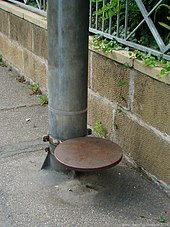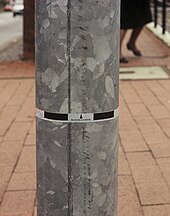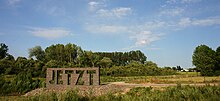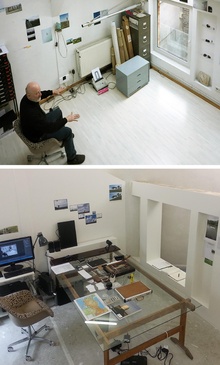Christian Hasucha
Christian Hasucha (* 1955 in Berlin-Neukölln ) is a German street art and installation artist who has gained notoriety through his public interventions . This is a series of installations presented in public space since 1981.
Life
Hasucha studied fine arts from 1975 to 1981 at the HdK Berlin (now UdK Berlin), immediately afterwards received a DAAD scholarship in London and continued to study there at the Chelsea School of Art . With the exception of the years 1988 to 1996, which he spent in Cologne and a one-year work trip through the outskirts of Europe in a workshop vehicle, he lives and works in Berlin.
His works have been on view in numerous locations since 1978, and the public interventions were mostly supported by the communities or the art associations. Since 1984 he has lectured at the HdK Berlin, the Chelsea School of Art (London), the Trondheim Art Academy , the University of Greifswald, the Art University Linz and the University of Cologne . From 2001 to 2003 Hasucha also held visiting professorships for “Aesthetics in Theory and Practice” at the University of Kassel , Faculty of Architecture, and for “Art in Public Space and New Artistic Strategies” at the Bauhaus University in Weimar, Faculty of Design.
plant
Hasucha has been initiating so-called public interventions across Europe since 1981 . He often installs irritating and contradicting objects, which he calls implants , in public spaces. These implants range from very small objects to replicas of rooms and passageways. The first intervention took place in Budapest in 1981 , where Hasucha presented the wings of a rocket in public places. In London , during the second intervention, he changed puddles on damaged streets and gave them the shape of reptiles. The fourth Intervention Radio from 1984, funded by the International Building Exhibition in Berlin, consisted of a concrete radio in a Kreuzberg backyard that played a short loop of a crime film music for four weeks. The seventh intervention JETZT was presented in 1989 and 1990 in Cologne and Frankfurt am Main , with an actor sitting in an exposed spot next to a light box for three weeks in the evening and occasionally switching on the writing JETZT flashing into the evening sky.
The 16th intervention, called P, consisted of 50 steel platforms that were attached to public masts in Heilbronn , Graz and Cologne in 1993/94 just a few centimeters above ground level and that volunteers could use as they wish. In the 18th intervention Hasucha place in Langenhagen in a snack bar a bar table as the intersection between public and private space and marks this height of 5,000 piles of lanterns, utility poles and traffic signs throughout the city. Because of violent civil protests against this type of art, the City Council shortened the budget row spot for the coming year. During the 34th intervention in Pulheimer Rochade , an area of around 25 m² at the secondary school in Pulheim was exchanged for half a year for half a year in front of the Brauweiler Abbey five kilometers away, complete with road surfaces, bicycle stands and fences. During the 35th intervention by Günter's window , Hasucha recreated the window niche in the one-room apartment of his Berlin neighbor in Mülheim an der Ruhr in 2000 , who then looked out of his window every day for two weeks. The 37th Intervention Transfer placed sticky notes from Berlin street poles on pieces of pipe of equal thickness, which Hasucha in turn attached to street poles in Aschaffenburg.
During his 48th intervention in Münster-Coerde , he turned Hamann-Platz in Münster-Coerde by 180 ° for half a year. His 49th Eschbachzeit intervention was part of the Regionale 2006 in North Rhine-Westphalia; Hasucha let the houseplants of a Berlin rented apartment float on a raft corresponding to the floor plan of the apartment in their original position in the room on a lake.
The series of interventions continues to the present day. In 2007, the intervention was 52. Shortly before Heinde as part of agricultural work 07 and funded by the German Federal Cultural Foundation , the State of Lower Saxony, the city of Hildesheim, the Friedrich Ebert Foundation and the University of Hildesheim to see. It was an artificially created hill near Heinde , which, because of the built-in roller bearings, had to be climbed endlessly by bike. In the 53rd project Die Reise in 2008, a five-meter-long bar-shaped structure was transported in small batches across Eisenhardt Castle near Bad Belzig over a period of six weeks . In 2008 there was also the 55th project +28.33 , in which the temporary renovation of a gallery in Berlin-Moabit created 28.33 square meters of additional public space, as well as the installation maintenant for the project series Horizons Sancy 2008 , in which a 50-meter-long word made of letter pontoons was floating on a lake in the Auvergne near Murat le Quaire for three months . As part of the renaturation of the Seseke, the project Über Wasser Gehen took place in 2010 , in which Hasucha installed the stone sculpture JETZT and the river .
In 2012, Hasucha's design later won the Sparda Art Prize NRW . The envisaged ensemble, in which a small apple tree is to grow into the sweeping outline template of its own late shape, was installed on the Paderborn main station forecourt in summer 2013. In 2014 it was part of the urban art project Tatort Paderborn curated by Florian Matzner . In the same year Hasucha went on a six-month work trip with his workshop trolley that took him to the High Caucasus in Georgia. In autumn 2014, immediately after his return, he had a re-acclimatization room implanted in the Berlin-Neukölln gallery bauchhund salonlabor , which then essentially consisted of a nested replica of his office and some of his office equipment and furniture. His “real” office was about a kilometer away. In the semi-public gallery, Hasucha made another stop and worked here for five weeks on the documentation of his travel interventions before he moved back into the seclusion of his studio house.
In 2019 Hasucha won the competition for an artistic design for Nöldnerplatz in Berlin-Lichtenberg . The aim of the competition was to emphasize the square and the history of the quarter through a self-confident artistic statement. In January 2020 the work of art “Heaven over Nöldnerplatz” was inaugurated. According to Hasucha, “was inspired by the vastness and the open sky over the square. He feels reminded of previous travel experiences. He added a scene to the expanse and the plinthed lawn carpets of Nöldnerplatz, the complexity of which allows various associations: a house tent made of cast aluminum, closed on all sides, and a pole lamp will be in spatial and formal proportions to the western lawn. "
literature
- Christian Hasucha. Public Interventions , Verlag für Moderne Kunst, Nuremberg 2013
Web links
- Christian Hasucha's website
- Hasucha intervention "Fremd in Neuhausen" , Kunstverein Neuhausen (2003)
- Article about C. Hasucha , taz of July 12, 2006
- Sparda Art Prize NRW, City of Paderborn 2012
- Data on the life and work of Christian Hasucha at Public Art Wiki
Individual evidence
- ↑ Inauguration of the work of art “Heaven over Nöldnerplatz”. Press release from the Lichtenberg District Office, January 10, 2020.
| personal data | |
|---|---|
| SURNAME | Hasucha, Christian |
| BRIEF DESCRIPTION | German installation artist |
| DATE OF BIRTH | 1955 |
| PLACE OF BIRTH | Berlin |



